The SEL School: Connecting Social and Emotional Learning to Effective Teaching
Teaching the Whole Child: Instructional Practices That Support Social-Emotional Learning in Three Teacher Evaluation Frameworks
Research-to-Practice Brief, August 2013 | by Nick Yoder, Ph.D
Featured Brief

- What Is the Social and Emotional Learning School?
- Understanding Social and Emotional Learning
- SEL Tools for Educators
- SEL Tools for State and District Leaders
- Take the Self-Assessment
In the News
Blog
"New Report Offers Guidance to Help Meet the Needs of the Whole Child" by Peter DeWitt, Finding Common Ground, Education Week, September 2, 2013.
Great teachers do more than promote the student's academic learning–they teach the whole child. Social and emotional learning (SEL) is critical to the introduction of college and career readiness standards, which increase the demands on students' ability to engage in deeper learning, and shift the focus and rigor of instruction.
The Social and Emotional Learning School helps teachers, school and district leaders, and state education agencies collaborate in connecting social and emotional learning to effective teaching.
- New to SEL? “Understanding Social and Emotional Learning” offers an interactive graphic you can use to learn all about key SEL competencies and teaching practices.
- Are you looking for tools to support integrating SEL into your practice? “SEL Tools for Educators” explains action steps and GTL Center resources that can assist you.
- Are you a state or district leader looking for resources to support SEL policies? “SEL Tools for State and District Leaders” explains action steps and GTL Center resources that can support your policy planning and implementation.
- Are you a teacher interested in reflecting on your own SEL competencies and teaching practices? “Take the Self-Assessment” will walk you through using the GTL Center’s innovative, online reflection tool for social and emotional learning.
The GTL Center is committed to working at all levels of policy and practice to ensure that social and emotional learning is integrated into existing educator effectiveness reforms and professional development systems.
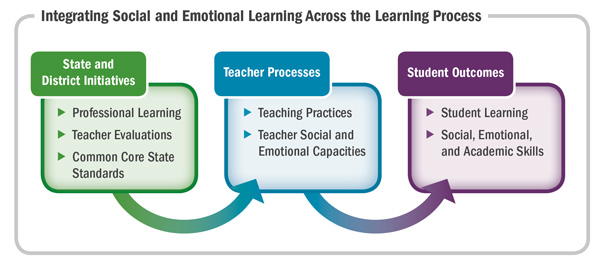
By making clear connections between SEL and the work educators are already doing, our resources can help you ensure that:
- Educators are not overburdened by layering on social and emotional learning as yet another 'initiative'
- Educator effectiveness reforms reinforce successful social and emotional teaching practices
- Educator effectiveness supports, including performance feedback and coaching, help teachers strengthen not only their social and emotional teaching practices but also their own social and emotional capacities.
For a detailed explanation (and corresponding references) of the research supporting the importance of SEL for students, check out our research-to-practice brief, Teaching the Whole Child: Instructional Practices That Support Social and Emotional Learning in Three Teacher Evaluation Frameworks.
Key SEL Organizations
For more information on SEL, check out these leading organizations:
Are you new to social and emotional learning? Explore the information and interactive graphic below to learn more!
What Is Social and Emotional Learning?
According to Collaborative for Academic, Social, and Emotional Learning (CASEL), social and emotional learning is the process of developing students’ and adults’ social and emotional competencies—the knowledge, skills, attitudes, and behaviors that individuals need to make successful choices. CASEL identifies five social and emotional competencies: self-awareness, self-management, social awareness, relationship skills, and responsible decision making. Explore our interactive graphic to learn more about these five social and emotional competencies.
Why is Social and Emotional Learning Important?
Quote to Note
"Instruction that does not address all of the facets of the child that inform and direct the learning process–with the notable inclusion of social and emotional factors will not effectively educate."1
-
SEL increases students' capacity to learn. Social and emotional competencies not only prepare students to participate in learning experiences, they also increase students' capacity to learn. Students who have participated in social and emotional programs demonstrate:
- Increased academic achievement
- Increased social and emotional skills
- Improved attitudes toward themselves and others
- Improved positive social behaviors
- Fewer conduct problems and less emotional distress
Did You Know?
Students with training in social-emotional learning gained an average of 11 percentile points on standardized test scores compared with students who did not receive the training.2
-
SEL Prepares Students to Meet College and Career Readiness Standards. To master the new academic standards, students will need to build the SEL skills all students need to be successful. For example:
- The Common Core State Standards for Mathematics entail a new level of focus, coherence, and rigor; when students become frustrated or confused by the content, they must learn how to persevere in meeting the new standards. If they do not know how to manage or regulate the emotions they have during school (e.g., joy, jealousy, frustration, relief), their mental resources will not be used for academic learning.
- The Common Core State Standards for English Language Arts require students to gather evidence from and interact with texts that are more complex. To successfully navigate these texts, students need to be aware of what they do and do not understand about the text (self-awareness) and be able to ask for help when they do not comprehend the text (self-management).
How Do Teachers Support Social and Emotional Learning? Teachers influence student social and emotional competencies through the teaching practices they implement in their classrooms and through the use of their own social and emotional competencies. Explore our interactive graphic that illustrates how student SEL is influenced by 10 teaching practices used in the classroom and teachers’ own social and emotional competencies.
1 Kress, J., Norris, J. A., Schoenholz, D. A., Elias, M. J., & Siegle, P. (2004). Bringing Together Educational Standards and Social and Emotional Learning: Making the Case for Educators. American Journal of Education, 111, p. 86).
2 Durlak, J. A., Weissberg, R. P., Dymnicki, A. B., Taylor, R. D., & Schellinger, K. B. (2011). The impact of enhancing students’ social and emotional learning: A meta-analysis of school-based universal interventions. Child Development, 82, 405–432.
Supporting Social and Emotional Learning: Action Steps for Educators
As the critical link in supporting social and emotional learning (SEL) in the classroom, educators can take concrete action steps to be sure all students have access to social and emotional learning opportunities.
School Administrator Actions:
- Implement an SEL learning program
- Integrate SEL into academic learning and curricular resources
- Provide teachers with professional learning experiences on SEL
- Look for instructional practices that promote or support SEL
- Connect SEL to other school policies and procedures, such as school climate, school vision and mission, or service-learning programs
Teacher Actions:
- Use specific instructional strategies and classroom management techniques, including those that foster a supportive, caring classroom environment
- Assess use of instructional strategies that support SEL in the classroom
- Assess students’ social-emotional competencies in the classroom
- Ask for feedback on SEL implementation from administrators, evaluators, or peers
- Implement or advocate for SEL school and district policies
SEL Tools for Educators
To support school leaders and teachers in taking action, we offer several resources to help connect social and emotional learning with effective teaching in your classrooms. Given the multitude of reforms and initiatives that you are already tasked with implementing, our tools are expressly designed to help you collaborate and integrate SEL into existing educator effectiveness initiatives, including:
- Teacher evaluation reforms, especially professional teaching frameworks
- Professional learning opportunities for teachers, including tools for self-assessment and reflections
Browse the resources below to learn how you can use these resources with colleagues in your school to:
1. Deepen Your Social and Emotional Knowledge
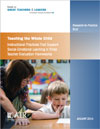 Teaching the Whole Child: Instructional Practices That Support Social-Emotional Learning in Three Teacher Evaluation Frameworks Research-to-Practice Brief | January 2014
Teaching the Whole Child: Instructional Practices That Support Social-Emotional Learning in Three Teacher Evaluation Frameworks Research-to-Practice Brief | January 2014
Does your district’s teacher evaluation system support you in developing students’ social and emotional competencies? Few educator evaluation systems explicitly address SEL or the teaching practices that support it. In this brief, you can:
- Learn about social and emotional learning and its importance for student success
- Examine 10 teaching practices that support social and emotional learning
- Explore a crosswalk of how three popular teacher evaluation frameworks already embed the 10 teaching practices in their language and descriptors.
2. Connect Teacher and Student Social and Emotional Learning to Your Professional Teaching Framework
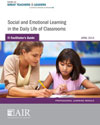 Social and Emotional Learning in the Daily Life of Classrooms Professional Learning Module | April 2014
Social and Emotional Learning in the Daily Life of Classrooms Professional Learning Module | April 2014
Integrating SEL into existing initiatives, including teacher evaluation, Common Core State Standards implementation, and professional learning, is no easy task. In this professional learning module, educators can work together to:
- Deepen knowledge and skills for integrating SEL into your daily instructional practices.
- Strengthen connections between SEL and your teacher evaluation system and professional development plans
- Self-reflect on your teaching practices that impact student social and emotional learning
- Self-reflect on your own social and emotional learning competencies that support these teaching practices
The module includes six hours of hands-on activities and materials that are designed to be customized and adapted to you and your colleagues’ unique needs. You can download PDF copies of the material or request copies in Microsoft Word format by emailing gtlcenter@air.org.
Developed in partnership among the Tennessee Department of Education, the Appalachia Regional Comprehensive Center (ARCC), and the GTL Center, this toolkit provides educators with resources for integrating social and emotional learning into their classrooms through Tennessee’s teacher evaluation system, the Tennessee Educator Acceleration Model (TEAM). Although the Toolkit is aligned with the TEAM model, other states and districts can also use the example teacher activities, student behaviors, model lessons, and discussion prompts to promote social and emotional learning in their classrooms.
3. Reflect on Your Social and Emotional Skills
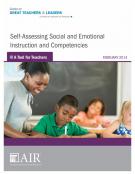 Self-Assessing Social and Emotional Instruction and Competencies: An Online Tool for Teachers | April 2014
Self-Assessing Social and Emotional Instruction and Competencies: An Online Tool for Teachers | April 2014
As you help students achieve new college and career readiness standards, teaching practices that promote student social and emotional learning in the classroom will be crucial to student success. With this online tool, you will be guided, step by step, to self-assess and reflect on 10 teaching practices that support social and emotional learning for students. The self-assessment tool, however, goes beyond these 10 teaching practices; you will also need to strengthen your social and emotional competencies to implement the 10 teaching practices successfully. These 5 competencies include:
- Self-awareness
- Self-management/emotion regulation
- Social awareness
- Relationship skills/social skills
- Responsible decision making
Take the self-assessment individually or bring together teachers in your school to use as part of a professional learning activity (see Social Emotional Learning in the Daily Life of Classrooms for ideas!).
Prefer good old paper and pencil? Download a Word copy of the SEL self-assessment tool.
4. Integrate Social and Emotional Learning into Policies
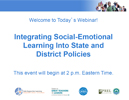 Integrating Social-Emotional Learning Into State and District Policies | December 2013
Integrating Social-Emotional Learning Into State and District Policies | December 2013
Educators recognize the important role social-emotional learning plays for student success in school, work, and life. This webinar, cohosted by the GTL Center, the National Center on Safe and Supportive Learning Environments (NCSSLE), the Collaborative for Academic, Social and Emotional Learning (CASEL), and the Pacific Comprehensive Center brings together a dynamic panel that discusses how states and districts are integrating SEL into their state and district initiatives. As a result of this webinar, participants will be about to:
- Identify reason why SEL is important and essential to impact student outcomes;
- Identify approaches states and districts have taken to implement SEL policies;
- Describe the role SEL plays in successfully integrating current education initiatives; and
- Implement strategies to integrate SEL into SEA and LEA initiatives.
5. Create a Positive School Climate
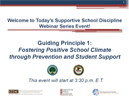 Guiding Principle #1, Climate and Prevention | February 2014
Guiding Principle #1, Climate and Prevention | February 2014
The first step in building safe and supportive schools conducive to academic excellence and student success is to create positive climates. The National Center on Safe and Supportive Learning Environment hosted a webinar that provided an in-depth review of Guiding Principal #1 as outline within the Guiding Principles: A Resource Guide for Improving School Climate and Discipline, a key document in the recently released School Discipline Guidance. In particular, it walked through each Action Step identified for Principle #1 implementation, including exploring how each are being implemented by an expert panel of practitioners. These content experts brought deep knowledge of the practical realities associated with integrating Principle #1 strategies into current practice.
Supporting Social and Emotional Learning: Action Steps for State and District Leaders
State and district leaders have a crucial role to play in establishing systematic supports for educators implementing social and emotional learning (SEL) in the classroom. Leaders can take concrete action steps to ensure that all teachers and leaders can provide students with social and emotional learning opportunities .
State Actions
- Adopt or develop SEL standards
- Explicitly include practices that promote or support SEL in educator evaluation systems
- Develop policies that focus on the implementation of practices that promote or support SEL
- Create tools to help educators quickly and easily see SEL in existing teacher evaluation tools
- Embed a focus on SEL in other initiatives (e.g., school climate, anti-bullying, teacher preparation, principal accountability)
- Promote collaboration across districts by encouraging sharing of successful strategies that build school cultures that support SEL
District Actions:
- Implement SEL programs that focus on teaching specific social-emotional competencies
- Explicitly include practices that promote or support SEL in educator evaluation systems
- Connect SEL to other district initiatives, including college and career readiness standards, school climate, and anti-bullying
- Create a process to continually assess the effectiveness of initiatives and programs designed to promote SEL
SEL Tools for State and District Leaders
To support state and district leaders in taking action, we offer several resources to help connect social and emotional learning with effective teaching in your districts and schools. Given the multitude of reforms and initiatives that you are already tasked with implementing, our tools are expressly designed to help you integrate SEL into existing educator effectiveness initiatives, including:
- Teacher evaluation reforms, especially professional teaching frameworks
- Professional learning opportunities for teachers, including tools for self-assessment and reflection
Browse the resources below to learn how you can use these resources with colleagues in your districts and schools to:
1. Deepen Educators’ Understanding of Social and Emotional Learning
 Teaching the Whole Child: Instructional Practices That Support Social-Emotional Learning in Three Teacher Evaluation Frameworks Research-to-Practice Brief | January 2014
Teaching the Whole Child: Instructional Practices That Support Social-Emotional Learning in Three Teacher Evaluation Frameworks Research-to-Practice Brief | January 2014
Does your state or district’s teacher evaluation system support teachers in developing students’ social and emotional competencies? Few educator evaluation systems explicitly address SEL or the teaching practices that support it. In this brief, you can:
- Learn about social and emotional learning and its importance for student success
- Find out how other states are using social and emotional learning standards to integrate SEL into policy and practice
- Examine 10 teaching practices that your educators can implement to support social and emotional learning
- Explore a crosswalk of how three popular teacher evaluation frameworks already embed the 10 teaching practices in their language and descriptors
2. Connect Teacher and Student Social and Emotional Learning to Your Professional Teaching Framework
 Social and Emotional Learning in the Daily Life of Classrooms Professional Learning Module | April 2014
Social and Emotional Learning in the Daily Life of Classrooms Professional Learning Module | April 2014
Integrating SEL into existing initiatives, including teacher evaluation, Common Core State Standards implementation, and professional learning, is no easy task. In this professional learning module, state and district leaders can work together to:
- Deepen knowledge and skills for integrating a SEL emphasis into your policy and planning work
- Strengthen connections between SEL and your teacher evaluation and professional development systems
- Learn strategies for supporting school leaders in guiding teachers to reflect on their own teaching practices and social-emotional competencies
The module includes six hours of hands-on activities and material that are designed to be customized and adapted to your state or district’s unique needs. You can download PDF copies of the material or request copies in Microsoft Word format by emailing gtlcenter@air.org.
Developed in partnership among the Tennessee Department of Education, the Appalachia Regional Comprehensive Center (ARCC), and the GTL Center, this toolkit provides educators with resources for integrating social and emotional learning into their classrooms through Tennessee’s teacher evaluation system, the Tennessee Educator Acceleration Model (TEAM). Although the Toolkit is aligned with the TEAM model, other states and districts can also use the example teacher activities, student behaviors, model lessons, and discussion prompts to promote social and emotional learning in their classrooms.
3. Support Educators to Strengthen Their Social and Emotional Learning Competencies
 Self-Assessing Social and Emotional Instruction and Competencies: An Online Tool for Teachers | April 2014
Self-Assessing Social and Emotional Instruction and Competencies: An Online Tool for Teachers | April 2014
As teachers help students achieve new college and career readiness standards, using teaching practices that promote student social and emotional learning in the classroom will be crucial to student success. With this online tool, your teachers will be guided, step by step, to self-assess and reflect on 10 teaching practices that support social and emotional learning for students. The self-assessment tool, however, goes beyond these 10 teaching practices; teachers also need to strengthen their social and emotional competencies to implement the 10 teaching practices successfully. These 5 competencies include:
- Self-awareness
- Self-management/emotion regulation
- Social awareness
- Relationship skills/social skills
- Responsible decision making
Teachers can take the self-assessment individually or you can provide resources for schools to bring teachers together for a professional learning activity (see Social Emotional Learning in the Daily Life of Classrooms for ideas!).
Prefer good old paper and pencil? Download a Word copy of the SEL self-assessment tool.
4. Integrate Social and Emotional Learning into Policies
 Social and Emotional Skills for Life and Career: Policy Levers that Focus on the Whole Child | March 2015
Social and Emotional Skills for Life and Career: Policy Levers that Focus on the Whole Child | March 2015
In this Policy Snapshot, find important state and district policy considerations for initiating and integrating SEL, as well as for preparing and developing teachers and administrators to focus on the whole child.
 Integrating Social-Emotional Learning Into State and District Policies | December 2013
Integrating Social-Emotional Learning Into State and District Policies | December 2013
Educators recognize the important role social-emotional learning plays for student success in school, work, and life. This webinar, cohosted by the GTL Center, the National Center on Safe and Supportive Learning Environments (NCSSLE), the Collaborative for Academic, Social and Emotional Learning (CASEL), and the Pacific Comprehensive Center brings together a dynamic panel that discusses how states and districts are integrating SEL into their state and district initiatives. As a result of this webinar, participants will be about to:
- Identify reason why SEL is important and essential to impact student outcomes;
- Identify approaches states and districts have taken to implement SEL policies;
- Describe the role SEL plays in successfully integrating current education initiatives; and
- Implement strategies to integrate SEL into SEA and LEA initiatives.
5. Create a Positive School Climate
 Guiding Principle #1, Climate and Prevention | February 2014
Guiding Principle #1, Climate and Prevention | February 2014
The first step in building safe and supportive schools conducive to academic excellence and student success is to create positive climates. The National Center on Safe and Supportive Learning Environment hosted a webinar that provided an in-depth review of Guiding Principal #1 as outline within the Guiding Principles: A Resource Guide for Improving School Climate and Discipline, a key document in the recently released School Discipline Guidance. In particular, it walked through each Action Step identified for Principle #1 implementation, including exploring how each are being implemented by an expert panel of practitioners. These content experts brought deep knowledge of the practical realities associated with integrating Principle #1 strategies into current practice.
6. State Resources
Tennessee SEL Resources

Michigan SEL Resources

Minnesota SEL Resources

Welcome! We developed the Social and Emotional Learning Self-Assessment Tool to help you reflect on the implementation of teaching practices that impact students' social and emotional competencies. This tool is not intended to be evaluative. Instead, it allows you to reflect on how your own social and emotional needs relate to your teaching practices.
New to Social and Emotional Learning?
Before you take the self-assessment, use our interactive graphic to learn about social and emotional learning competencies and teaching practices.
New to This Tool?
Use the steps below to create your personalized account:
- Create a log-in for your account so that you can save your work and print your reflections after you finish the assessment.
- After logging in, you will arrive at the dashboard. Select "Begin an Assessment" and start filling out the three sections of the tool.
- Return to the dashboard to print or review your completed self-assessment. You can take the self-assessment as many times as you would like.



